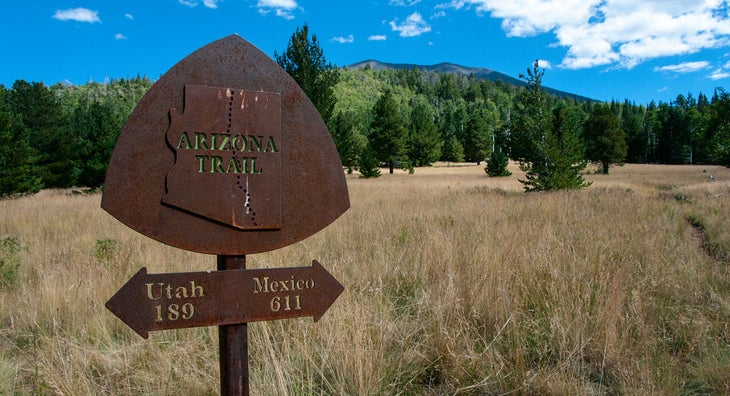New perk! Get after it with local recommendations just for you. Discover nearby events, routes out your door, and hidden gems when you sign up for the Local Running Drop.
The United States of America is a trail runner’s paradise. From coast to coast, the land exhibits an array of ecosystems and wonders. There are wild places, and trail systems that travel through them that provide access to soul-nourishing experiences for runners and hikers alike.
These places in the landscape inspire runners. Trail junkies are drawn to the raw exposure of the elements, the challenge of terrain untainted by cement and asphalt. Views untainted by buildings. Soundscapes untainted by horns or traffic.
If not for the many land policies that have been put into place over the course of our nation’s history, many of these places would be lost to shopping malls and subdivisions.
This year, Trail Runner wants to pay homage to the National Trails System Act, in celebration of the the 50th anniversary of its creation in 1968. Check out the 50th Anniversary website for more information, or celebrate at one of the events held throughout this year.
The National Trails System Act authorized the establishment of the Appalachian and Pacific Crest Trails, to name a few, providing outdoor recreation opportunities throughout the country. The system has since grown significantly to include 11 National Scenic Trails and 19 National Historic Trails covering over 55,000 miles through 49 States.
Over the course of the past half century, countless Fastest Known Time records covering these very trails have been set and broken by runners over and over, from the Arizona Trail to the North Country Trail. These trails are also top destinations for elite and novice runners alike; as an ode to their contribution to the sport, trail runner will be featuring some of our favorites throughout the year.
The Arizona Trail

The Arizona Trail (AZT) stretches over 800 miles across the state from the Mexico border to Utah. The trail showcases the many ecosystems and varied terrain of Arizona: from the sonoran desert to the high alpine forests of the Kachina Peaks to the bottom of the famed Grand Canyon and across the Colorado river. The diversity of wildlife and geology is is rivaled by the diversity of trail accessibility and difficulty levels. There are parts of the AZT which are so wild and remote you may feel like growing out claws and fur, while other stunning sections are easily accessible, making for a good afternoon jaunt. Some sections are flat and flowy, but others present serious climbing challenges and technical terrain.
The trail was dreamt up by Dale Shewalter in 1970s while living in Flagstaff, Arizona. After walking various sections of Arizona and giving numberous presentations about the feasibility of a trans-state trail, his vision gained the support of land managers across the state. Throughout the late 1980s and 1990s, the trail was planned, coordinated and constructed by connecting various existing trails with Shewalter taking the lead.
Favorite Trail Runs on the AZT

Grand Canyon: How could this section not make the list? The AZT travels from the South Kaibab Trailhead to the North Kaibab Trailhead, dropping nearly 5,000 feet over seven miles before ending at the colorado river in the bottom of the canyon. From there, the trail continues up the 14-mile-long North Kaibab trail, ascending nearly 6,000 feet to the north rim. Running in the canyon is surreal, and one can do any variation of an out-and-back, starting from either trailhead, or tackle the famous rim-to-rim-to-rim (a brutal 55-mile endeavor). The best time of year to run here is in the spring and fall; in the summers, the bottom of the canyon is blazing, while the winters make for icy sections near the rims. Prepare for the elevation changes with lots of layers, and make sure to bring plenty of water since the only water access along the Kaibab is at the river!

San Francisco Peaks: This eye-catching mountain range outside of Flagstaff has the state’s highest peak, Mount Humphrey, with a summit reaching 12,621 feet. The AZT skirts around the west side of the range, passing through stunning aspen groves and prairies. Drive up Snowbowl Road to Aspen Corner, and run along the marked AZT over rolling hills surrounded by views of the peaks for a fun out-and-back, or take a detour to tackle the Humphrey or Kachina trails nearby (not a part of the AZT, but a common detour for many thu-hikers). Prime time is all summer, where the temps are unparalleled, and into the fall, when the aspen groves change to golden fields of bliss. Mentally prepare for the high altitude and the resulting gasp-fest!

Superstition Wilderness: The superstition wilderness outside of Phoenix hosts some of the most rugged and breathtaking desert terrain on the AZT. This passage stretches from Rogers Trough trailhead on the south end of the wilderness area all the way to Theodore Roosevelt Lake on the north end: a 30-mile stretch through canyons and hills. If attempting a run in this area, bring ample water and sun protection, regardless of the distance. The best time is in the winter and spring, where cooler temps and blooming wildflowers are ample.

Santa Catalina Mountains: Featuring southern Arizona’s premier desert mountains, the Santa Catalinas include an 18.5 mile passage that stretches from the Gordon Hirabayashi Campground on the southern end to the Marshall Gulch trailhead in the north. Views of Mount Lemmon and the surrounding foothills are full of intriguing rock formations and terrain. The best time to explore the Catalinas are from the fall through the spring.
For more information about routes, conditions and history of the trail, visit the Arizona Trail Association website.
Speak up! Trail Runner wants to get YOUR input. Have a favorite section of one of the National Scenic Trails? Send in stories, tips and photos to instagramtr@bigstonepub.com